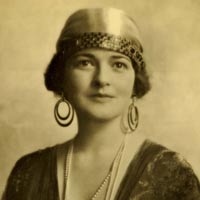Portraits in Paradise at the SB Historical Museum
Photographic Exhibition Runs through June 10
he last exhibit at the Santa Barbara Historical Museum, Guiding Lights, brought attention to the artistic colony that thrived in Santa Barbara during the first third of the 20th century. The museum’s new show, Portraits in Paradise, moves in closer for an intimate view of the men—and notably, the women—who played significant roles in the development of the city during that same period. Guest curator Barbara Vilander has brought together a series of portraits that illuminate the energy and entrepreneurial spirit that characterized Santa Barbara in the 1920s and ’30s, as well as the exciting developments the Gledhills brought to the tradition of photographic portraiture.

Edwin and Carolyn Gledhill married in 1907 and set up their first portrait studio in Santa Barbara that same year. Unlike many photographic duos in which one member specialized in shooting images and the other in processing the film, the couple worked together in the studio. Edwin would pose the subject and work to elicit the perfect response. When Carolyn saw what she wanted, she would release the shutter. The resulting images reflect the complementary talents of husband and wife while at the same time capturing the essence of the man or woman seated before the camera.
As Staci Gem Scheiwiller argues in her exhibition catalogue essay, Carolyn Gledhill’s decisive role in the process yielded new images of women: women of power and character whose defiance and intelligence radiate from these prints. Take for example a portrait of Elizabeth Bakewell Knowles, circa 1925. Knowles was a painter and scenic designer for theater and opera productions in Santa Barbara. She appears here in a classic profile that highlights her strong facial features. Her chin is raised in a dramatic gesture, her short hair curls from beneath a velvet hat, and she wears a fur stole draped over one shoulder. The subject of this image is unquestionably powerful, immortalized in an image that acknowledges her status as an artist and a professional.
Another painter, Hudson River School member Thomas Moran, appears in a portrait from 1921. With his palette and brushes in hand and a distinguished white beard framing his kind face, Moran appears as a latter-day Rembrandt. In this image, the Gledhills achieved a painterly effect by manipulating the print during processing. Moran’s portrait seems almost to be composed of brushstrokes on canvas, emphasizing the photographers’ role as artists in their own right.
From their portrait studio on Chapala Street, the Gledhills captured many Santa Barbara luminaries: playwrights and journalists, authors and philanthropists. No image better captures the hope and vitality of this period better than that of Carolyn B. Hastings, who seems to look above and beyond the lens to something glimmering on the horizon.



